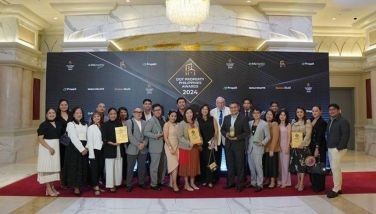The emperor’s ingredients
There was no emperor at the table, but rather a self-described “humble chef” in stylish dark blue chef’s garb with matching rubber clogs, a diamond in one ear and a spoon in his sleeve pocket. Celebrity chef Jeremy Leung is back in Manila, at the Conrad Hotel to be exact, for China Blue’s Legendary Chef Series 2024, The Emperor’s Table (the special menu runs until Sept. 30).
It’s a bit of a misnomer really, as the six-course meal is not imperial over-the-top gastronomy but rather a carefully curated, very clean selection of dishes featuring some unique and surprising ingredients. It was a delight to have Chef Jeremy annotate each dish, with valuable side notes (like cooking the drunken king prawn at just 56 degrees so it doesn’t overcook) that 40 years in the kitchen affords.
Serving as a Master Chef China judge for seven years opened up to him the immense culinary and gastronomic richness of the country, way, way beyond the southern/Guangdong style that he had earlier trained in and that most of us are familiar with. He visited places cosmopolitan and remote, dined in rooms with chandeliers and in rural cottages with mud floors, and discovered ingredients – often serendipitously – that piqued his ever creative mind. Some of these ingredients have happily found their way to China Blue’s Emperor’s Table.
From Hangzhou in southeastern China he brought sturgeon tendon, the muscle on the back of the fish that allows it – and those who eat it, he joked – to “swim very fast.” He explained that with overfishing severely depleting the sturgeon population in Russia, Hangzhou has become the largest producer of caviar from farmed sturgeon. “After you harvest the caviar, what happens to the rest of the fish?” he asked rhetorically. So the tendon found its way into a most comforting and intense but soothing double-boiled soup, enhanced with morel and matsutake mushrooms from Yunnan province in western China (where, by the way, the famed pu’erh tea comes from). By the way, China now accounts for 80 percent of world production of matsutake mushrooms, the chef shared.
The search – foraging might be a good word to use here – for new ingredients continued with an innocuous-looking spiral of green resting beside a trio of wagyu beef cheeks. It’s green bamboo shoot, also called stem lettuce or Chinese lettuce. Usually, Chef Jeremy explained, it’s the leaves of this celtuce that are eaten but, like the sturgeon tendon, the stem was “rescued” and featured as a delightfully crunchy and clean – I use this description a lot for this meal, meaning there’s nothing cloying about this food – accompaniment to the beef.
It’s called Yin Yang rice, but it’s not really rice. There’s orzo, an Italian pasta that looks like a large grain of rice, plus the fascinating Tibetan rock grain which, again, is not a grain but the seed of a plant that grows wild among the rocks in the high (about 3,000 meters above sea level) reaches of the Himalayas in Tibet and Nepal. These two “grains” were delicately braised with dried scallops and dried fish maw, and served with a succulent fried oyster. I could not resist picking apart the elements of this dish, especially the rock grain/seed one by one (my ancestors would be proud of my dexterity with chopsticks!), trying to determine its texture and character (still can’t quite put my finger, or taste buds, on it).
Not to be outdone, China Blue’s star chef, the most amiable but quite shy Chef Khor Eng Yew, prepared a perfectly roasted black cod (the description crunchy on the outside, moist and silky on the inside certainly applies here) with a delectable gravy that had buds of the torch ginger (a flower often used in arrangements that is a popular food ingredient in Chef Khor’s native Malaysia) and pomelo, spiced with drops of chili oil. I have to say that as long as Chef Khor is in the kitchen, China Blue is in deliciously good hands. And with restaurant operations manager Jane Domingo – whose mind is like a computer that registers guests’ preferences and idiosyncrasies (mine included) – overseeing a mindful staff, no wonder the restaurant with a view (sadly now marred by mounds of sand and gravel used for reclamation works) is usually full.
Dessert was a scene stealer, half an egg shell made of chocolate filled with a white coconut mousse and a “yolk” of pureed mango – very Instagram-able, if the term is still in vogue.
With eight restaurants – and four more in the offing, one at the Conrad in Kuala Lumpur, two in China and one he would not talk about – in six continents, Chef Jeremy travels over 180 days of the year, but in his home in Shanghai are rooms – three, I think he said – filled with over 15,000 cook books (he initially said 150,000, then corrected himself, blaming his low grade in math in his A levels) which he has had his assistants scan; definitely a tall order that has led to two of them quitting (the third has been with him for 22 years).
You could say Chef Jeremy has the world as his kitchen. And his pantry too, stocked with ingredients dictated by the seasons and growing with discoveries made during his constant travels. I hope he would, on one of his trips to our country, do some foraging here too, for I do believe we have some pretty interesting ingredients that can, like fish tendons and rock seeds, find pride of place on the plate at one of Jeremy Leung’s famed restaurants.
- Latest



























